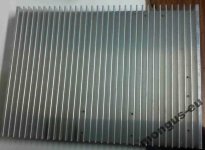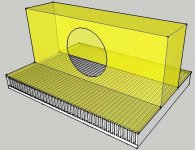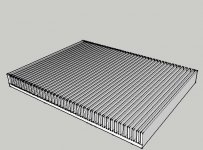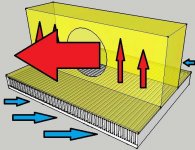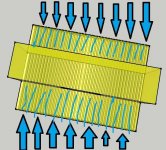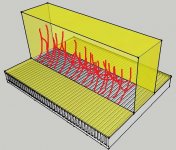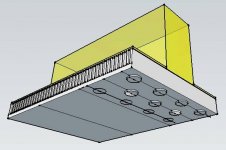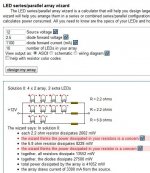Hi,
I'm workin on this DIY of my own LED grow light. Equipment which I prepared is:
DC 12V 20A 240W Switch Switching Power Supply Driver For LED Strip 110V/220V AC
20pcs of: 3W 620-630nm(VF: 2,2-2,8V, IF: 1100mA)
20pcs of: 3W 650-660nm(VF: 2,2, IF: 750mA)(reverse voltage 5,0V)
6 pcs of: 3W 6500-7000K white (VF: 3,4-3,6V, IF: 700mA)
15pcs of: 3W 470nm(VF: 3,2-3,6V, IF: 650mA)
5pcs of: 1W 440nm(VF:3,2-3,8V, IF:350mA)
2 pcs of Al heatsinks (237*325*30mm, 3,2kg)
Air cooling system:
Basically I'm gonna use my Vents TT 125 Fan (280m3/h), with reduced voltage. Each heatsink gonna be conected through pipeline, to fan. I think you can see it clearly on pictures. I realy hope it's gonna have enought power to cool all diodes. On pictures you can see only one heatsink, in box its gonna be second one next to him.
I've got problem with electrotechnical stuff, with LED array.
On 1. heatsing it'll be:
10+10 red one, 3xWhite, 8x470nm blue + 2x 440nm blue.
2. heatsing:
10+10 red one, 3xWhite, 7x470nm blue + 3x 440nm blue.
I'm using this calc: http://led.linear1.org/led.wiz
and it told me:
the wizard thinks the power dissipated in your resistors is a concern
And also it says that 10pcs of 630nm LED's total power dissipated by the array is 41052 mW. and thats weird because 10*3W led's = 41W ?
Can any one help me with this? I've need to design these LED arrays... And I'm totaly lost. I mean TOTALY
And I'm totaly lost. I mean TOTALY 
Thx
M.
I'm workin on this DIY of my own LED grow light. Equipment which I prepared is:
DC 12V 20A 240W Switch Switching Power Supply Driver For LED Strip 110V/220V AC
20pcs of: 3W 620-630nm(VF: 2,2-2,8V, IF: 1100mA)
20pcs of: 3W 650-660nm(VF: 2,2, IF: 750mA)(reverse voltage 5,0V)
6 pcs of: 3W 6500-7000K white (VF: 3,4-3,6V, IF: 700mA)
15pcs of: 3W 470nm(VF: 3,2-3,6V, IF: 650mA)
5pcs of: 1W 440nm(VF:3,2-3,8V, IF:350mA)
2 pcs of Al heatsinks (237*325*30mm, 3,2kg)
Air cooling system:
Basically I'm gonna use my Vents TT 125 Fan (280m3/h), with reduced voltage. Each heatsink gonna be conected through pipeline, to fan. I think you can see it clearly on pictures. I realy hope it's gonna have enought power to cool all diodes. On pictures you can see only one heatsink, in box its gonna be second one next to him.
I've got problem with electrotechnical stuff, with LED array.
On 1. heatsing it'll be:
10+10 red one, 3xWhite, 8x470nm blue + 2x 440nm blue.
2. heatsing:
10+10 red one, 3xWhite, 7x470nm blue + 3x 440nm blue.
I'm using this calc: http://led.linear1.org/led.wiz
and it told me:
the wizard thinks the power dissipated in your resistors is a concern
And also it says that 10pcs of 630nm LED's total power dissipated by the array is 41052 mW. and thats weird because 10*3W led's = 41W ?
Can any one help me with this? I've need to design these LED arrays...
Thx
M.

